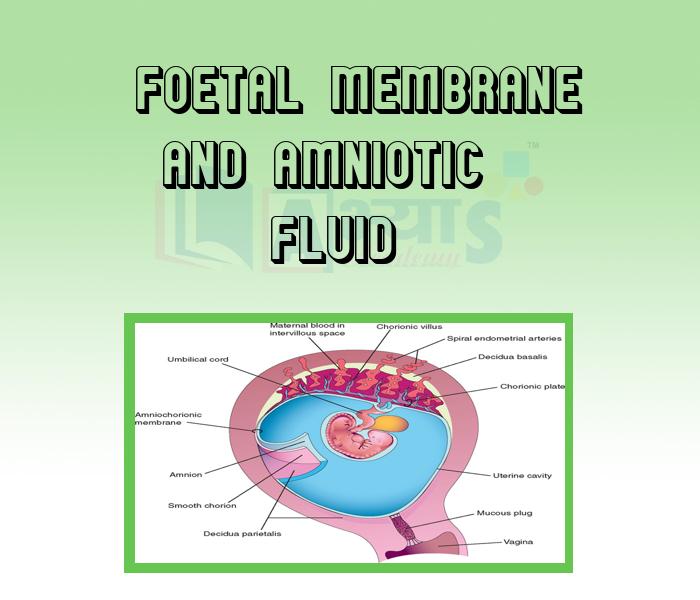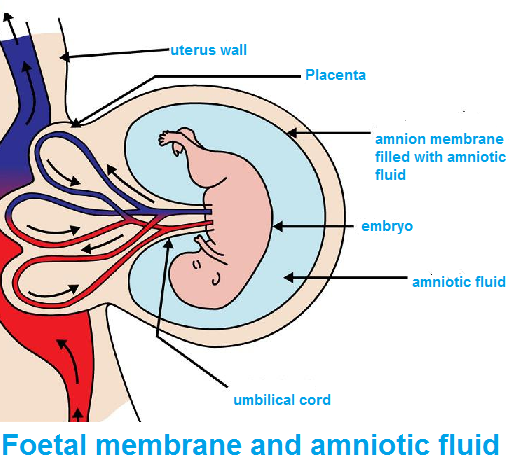Foetal Membrane And Amniotic Fluid













Foetal Membrane And Amniotic Fluid
In addition to the embryo proper, the blastoderm gives rise to certain other structures which lie outside the embryo. These are called as foetal membranes or extra embryonic membranes. These are essential for the complete development of the embryo. These include chorion, amnion , allantois and yolk sac.
Chorion
It completely surrounds the embryo and protects it . It consists of ectoderm outside and mesoderm inside. It takes part in the formation of placenta for the exchange of materials between the foetus and the mother.
Amnion
It is formed just above the embryo, It consists of ectoderm inside and mesoderm outside. The space between the embryo and the amnion is called as amniotic cavity. It is filled with a clear, watery fluid secreted by both the embryo and the membrane.
The amniotic fluid performs many important functions :-
1. Prevents drying of the embryo.
2. It cushions the embryo, protecting it against bumps and pressure of the maternal organs.
3. It maintains constant temperature and pressure.
4. It prevents bacterial infections.
5. It permits foetal movement.
Allantois:
It is a sac-like structure which arises from the gut of the embryo near the yolk sac. Allantois is formed of endoderm inside and mesoderm outside. In man the allantois is small and forms blood vessels of placenta and blood cells.
Yolk Sac:
It is a relatively larger sac-like structure formed below the embryo. It contains fluid, but not yolk. Its wall consists of endoderm inside and mesoderm outside. The yolk sac is non functional in human beings. The yolk sac is responsible for forming blood cells until about 6th week.

Students / Parents Reviews [10]
Abhyas is a complete education Institute. Here extreme care is taken by teacher with the help of regular exam. Extra classes also conducted by the institute, if the student is weak.

Om Umang
10thAbhyas Methodology is very good. It is based on according to student and each child manages accordingly to its properly. Methodology has improved the abilities of students to shine them in future.

Manish Kumar
10thIt has a great methodology. Students here can get analysis to their test quickly.We can learn easily through PPTs and the testing methods are good. We know that where we have to practice

Barkha Arora
10thMy experience with Abhyas is very good. I have learnt many things here like vedic maths and reasoning also. Teachers here first take our doubts and then there are assignments to verify our weak points.

Shivam Rana
7thI have spent a wonderful time in Abhyas academy. It has made my reasoning more apt, English more stronger and Maths an interesting subject for me. It has given me a habbit of self studying

Yatharthi Sharma
10thOne of the best institutes to develope a child interest in studies.Provides SST and English knowledge also unlike other institutes. Teachers are co operative and friendly online tests andPPT develope practical knowledge also.

Aman Kumar Shrivastava
10thAbout Abhyas metholodology the teachers are very nice and hardworking toward students.The Centre Head Mrs Anu Sethi is also a brilliant teacher.Abhyas has taught me how to overcome problems and has always taken my doubts and suppoeted me.

Shreya Shrivastava
8thMy experience with Abhyas academy is very good. I did not think that my every subject coming here will be so strong. The main thing is that the online tests had made me learn here more things.

Hiya Gupta
8thIt was a good experience with Abhyas Academy. I even faced problems in starting but slowly and steadily overcomed. Especially reasoning classes helped me a lot.

Cheshta
10thBeing a parent, I saw my daughter improvement in her studies by seeing a good result in all day to day compititive exam TMO, NSO, IEO etc and as well as studies. I have got a fruitful result from my daughter.
